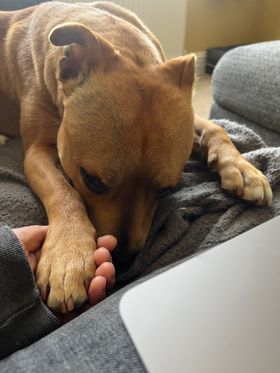Touching grass (and shrubs, and flowers, and dog)
I meant to post this in May, but then I went back to work after my final (sob) sabbatical, and I also lost a lot of time to Blue Prince at some point, so here we are in July.
I thought I'd update with some medium-sized news in the form of a medium-sized dog:

Her name is Penny. She's a staffy mix (and a rescue, so the rest is a mystery) and she's the cuddliest dog you've ever met. We've been working hard on lead training, as she is a terrible goblin on the lead and wants to chase anything small and furry, but then she makes up for it by doing things like this:

Designing the front garden
I spent most of my May sabbatical gardening: it was finally time to tackle our massively overgrown front garden. My original plan was to get someone in to design the space (just a planting scheme, nothing hugely fancy) but the cheapest quote I got was £1500. So I decided I'd do it myself - how hard could it be? (the answer is very) - and spent some quality time with a (now rather chewed, thanks to Penny) copy of What Plant Where. I made a spreadsheet of all the plants that would work in our heavy clay soil, organised into whether they're shade-lovers (for the north-facing bed) or sun-lovers (for the south-facing bed). I even used a colour scheme generation tool (coolors
) that I often use for web development to find colour combinations that worked for the beds.
It's important to find a mix of plants that provide year-round interest, so you don't end up with a riot of colour in summer and a sad wasteland the rest of the year. So in my spreadsheet I also included what months the plants are interesting in and made sure to include a good number of evergreens. I've gone for a lot of plants that pollinators like: foxgloves, lavender, teasel.
I ended up with something like this:

On the shady side, I'm going for hostas and ferns to provide a bit of foliage; delicate white blooms that will really pop out against the green; and dots of blue and purple to provide some colour.
On the sunny side we've got brighter colours: yellows, purples, oranges, pinks and even a bit of red.
The next step was to produce a scale drawing of the plot. It's quite a uniquely shaped plot as we live on the corner of a road, so I used Google Maps' satellite view to get an overview of the shape. I measured each wall, and drafted it out on graph paper at a scale of 2cm=1m.
I spent a while coming up with the shape of the lawn: I wanted big flowerbeds, but also a bit of grass in the middle. Curves were important to give a sense of movement and flow as opposed to the very constrained and formal feel of straight borders.
Finally, it was time to add in the plants. Starting from the outside, I stuck the shrubs in first and then worked inwards, putting taller plants towards the back and making sure the design left plenty of room for plants to spread out. As a rule of thumb (so I have learned), you want to plant herbaceous plants in 3s or 5s, never on their own and not in even numbers because it looks weird.

Planting it up
It's going to take me several years to get the garden to where I want it to be, as there are still a few shrubs that need to come out, and a lot of bed space that needs to be cleared. It's the wrong time of year to be doing this really (autumn would be better, and the ground's rock solid in the heat). But I've officially done one corner, with the help of my mum and several bags of very strong-smelling manure.
I've planted a deutzia and a daphne - two lovely pale-flowering shrubs, the daphne flowering in late winter/early spring - and surrounded them with some white erysimum (wallflowers). At the front of the border (by the lawn) we've got some brunnera macrophylla, a favourite of mine with these beautiful massive silver veined leaves and tiny blue forget-me-not flowers. The lovely thing about many perennials is that you can actually split them up into smaller plants, saving a bit of money as you don't need to buy so many. One brunnera became two, and two erysimums became three.
Pelican Town's economy is safe for now
I was looking forward to living my best Stardew Valley life this summer, growing fruit and veg in the back garden. In reality, the birds got all my strawberries (I didn't cover them over well enough) and the leaves of my potato plants have been absolutely devoured by tiny flies so god only knows whether I'll get any potatoes this year. I've successfully grown some chard and cavolo nero, though, and I have some very good cucumbers growing on a plant that was supposed to be a courgette. There are also early signs we might have a few raspberries this year (though literally only a few). At least I've learned things for next year!